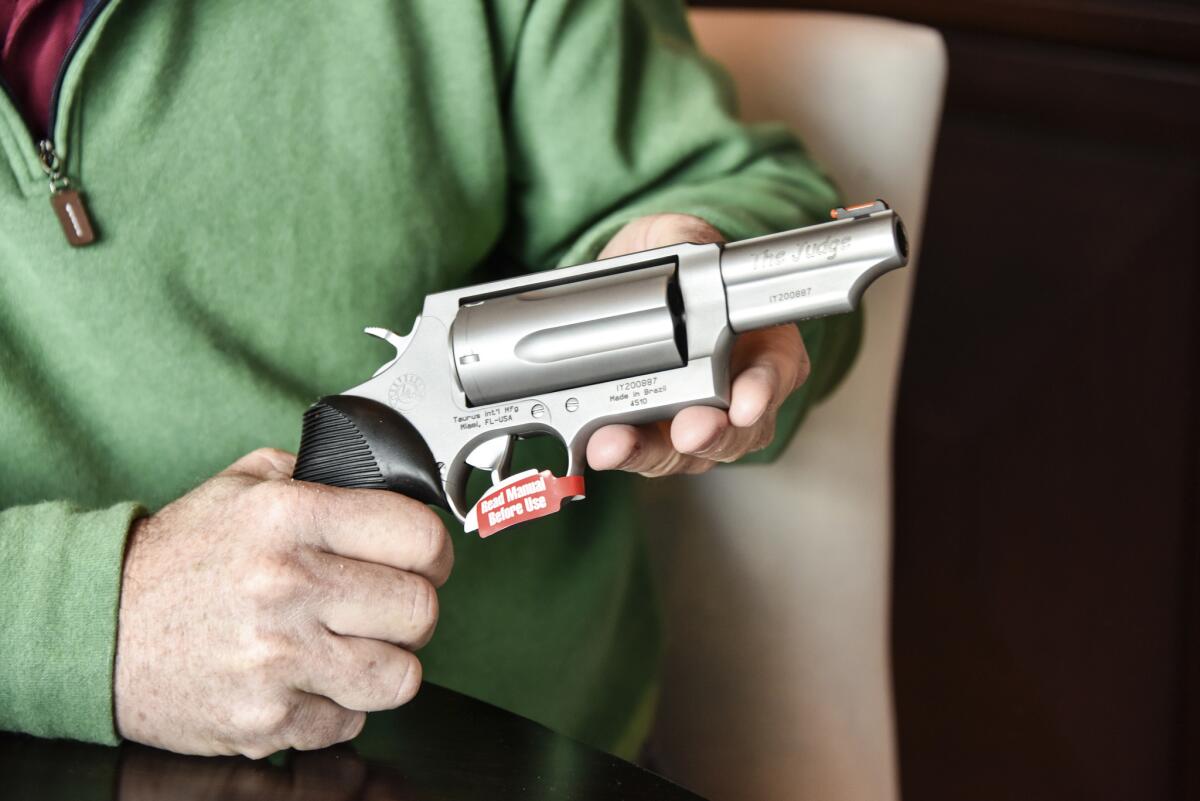Op-Ed: Guns are designed to kill. So why do we express shock when they do?

Lance Toland, the owner of Lance Toland Associates, an aviation insurance company with three offices in Georgia, holds a Taurus revolver, in Atlanta on Feb. 26, 2016.
- Share via
Within one 24-hour period last month, two gun accidents involving Californians echoed briefly through the news.
On March 6, Lana Meisner, wife of former Eagles bassist Randy Meisner, unintentionally shot and killed herself when she jostled a rifle stored in a closet in her Studio City residence. The following morning, the sound of a gunshot in a Sacramento home led a mother to discover her 2-year-old daughter bleeding on the floor.
One bullet found an adult; the other a child. One bullet came from a rifle; the other from a handgun. One was reported across the nation; the other was mainly a local concern. One led to a death, the other to a toddler in the hospital.
Despite such different circumstances, the news coverage of these two incidents had one thing in common: a sense of mystery. Police sources, according to The Daily Mail, considered Meisner’s death “a freak accident.” The Sacramento Bee said detectives were “trying to determine how the toddler gained access to the gun and who owned it.” Guns are designed to do exactly one thing, but we remain shocked when they do it. Their capacity to do what they were made to do is a reliable source of surprise.
We are, it seems, in the midst of a “somehow” epidemic--and we have been for a long time.
Indeed, the word most often used to describe the conditions that lead to such mishaps is nearly always the same: “somehow.” In just the last few weeks, anyone scrolling through social media feeds could have read it repeated like a mantra in a litany of stray bullets and bad luck.
In Utah, a man in charge of setting up targets on a shooting range “somehow” received a bullet intended for a bull’s-eye. In Florida, a gun rights advocate was driving with her son when she heard a bang and felt a pain in her back. “The small child was sitting in the vehicle’s backseat, right behind his mother,” one news item said, “and somehow got his hands on her handgun.” In Michigan, an 11-year-old boy was killed when “somehow he got a hold of a gun and started playing with it.” And in Kentucky, the shooting of another boy was described as if there had been no shooter involved: “While there at a gathering with several other kids and adults, police say the 8-year-old was somehow shot.”
The list of this year’s “somehow” shootings could go on and on. We are, it seems, in the midst of a “somehow” epidemic — and we have been for a long time.
Since the earliest days of the colonial press, widely published newspaper accounts often known as “Melancholy Accidents” recorded the consequences of mistakes, misfires and mishandled weapons in gruesome detail.
Readers in Philadelphia, for example, could have opened up their copies of the Pennsylvania Gazette on Oct. 28, 1745, to learn of a pistol that “unhappily went off.” After the unhappy pistol shot a butcher “through the head in such a manner that some of his brains came out,” its victim “fell down dead without speaking a word.”
With every stray bullet, the question of how such a thing could have come to pass was never far behind. Early on, the answer tended to be Providence. “If heaven send misfortune,” one accident report writer mused, “why should we repine?”
Eventually writers replaced pious explanations with a secular shrug that the slings and arrows of outrageous fortune had apparently acquired more firepower. By the middle of the 19th century, Americans were reading about the 15-year-old boy in Illinois who “somehow shot himself in the top of the head” or the 12-year-old boy in Kansas who “somehow” lost his foot to a shotgun blast. Throughout the 20th century, despite how much the country had changed, the “somehows” at least had not. When a boy hunting pigeons stumbled in the hills about San Rafael in 1954, he “somehow shot his father,” killing the man on the spot. When a girl went hunting in upstate New York in 1963, “she somehow shot herself with a 12 gauge shotgun,” and her father discovered her body.
In our national mythology, guns are symbols of liberty and autonomy, self-determination and control. When they harm us and there is no obvious person to blame, we want to believe they only do so “somehow.” Such linguistic tics subtly attribute gun failure and misuse to forces beyond our control, which is more comforting than admitting they are born of the choices we make.
This tendency was not lost on at least one compiler of gun accident reports. In an 1837 account of a brother who had accidentally shot his sister, the unnamed writer lamented, “How often and how vainly has the warning been reiterated — never to sport with fire arms?” He did not blame “somehow,” noting instead other preconditions necessary for gun accidents to occur: “The folly — the wickedness — the guilt.”
Gun accidents happen because we live in close proximity to machines designed to kill; they eventually will do what they were made to do, though perhaps not at a time our choosing. Whenever this happens, the true culprit is obvious: A culture that refuses to learn the lessons of its past.
Peter Manseau is the author most recently of “Melancholy Accidents: Three Centuries of Stray Bullets and Bad Luck.”
Follow the Opinion section on Twitter @latimesopinion and Facebook
More to Read
A cure for the common opinion
Get thought-provoking perspectives with our weekly newsletter.
You may occasionally receive promotional content from the Los Angeles Times.









